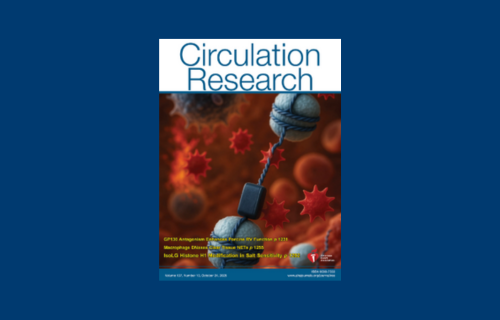Macrophage DNases Limit Neutrophil Extracellular Trap–Mediated Defective Efferocytosis in Atherosclerosis
Tuesday, 28 October, 2025
Share

Congratulations to UCD School of Medicine and UCD Diabetes Complications Research Centre’s Dr Eoin Brennan, Professor Catherine Godson and Tanwi Vartak (recently completed PhD student and second author) on their recently published paper titled, ‘Macrophage DNases Limit Neutrophil Extracellular Trap–Mediated Defective Efferocytosis in Atherosclerosis’. The team worked closely with Dr Manikandan Subramanian from Queen Mary University of London (QMUL)
The study was published in Circulation Research and featured on the cover of the October issue. It was a collaborative project made possible by the UCD Cointreau Seed Fund. This allowed the team to work with some of the vascular surgeons at St. Vincent’s University Hospital and perform key experiments for the QMUL group.
Abstract
BACKGROUND:
Neutrophil extracellular traps (NETs) contribute to atherosclerosis progression and are linked to adverse clinical outcomes such as myocardial infarction and stroke. Although the triggers of NET formation in plaques are known, the mechanisms governing DNase-mediated NET clearance and how these are disrupted during atherosclerosis remain unclear. Moreover, the consequences of impaired NET clearance on disease progression are not known.
METHODS:
Low-density lipoprotein receptor knockout (Ldlr−/−) mice with hematopoietic cell–specific deletion of DNase1 and DNase1L3 were fed a Western-type diet for 16 weeks to examine the impact of loss of DNase activity and the subsequent NET accumulation on advanced atherosclerosis. The effect of NETs on macrophage efferocytosis was examined in vitro and in the mouse peritoneal cavity and atherosclerotic plaque in vivo. To identify the signaling pathway impairing the NET-induced DNase response, in vitro assays were performed using selective endoplasmic reticulum stress pathway inhibitors, and the findings were validated in murine and human atherosclerotic tissues.
RESULTS:
Lack of DNase secretion by macrophages led to accumulation of NETs in local tissues, including atherosclerotic plaques. Persisting NETs in turn promoted cleavage of the efferocytosis receptor MerTK (c-mer proto-oncogene tyrosine kinase), resulting in defective macrophage efferocytosis and increased atherosclerotic plaque necrosis. In vitro screening identified endoplasmic reticulum stress–induced activation of the PERK (protein kinase R–like endoplasmic reticulum kinase)–ATF (activating transcription factor) 4 signaling axis in atherogenic macrophages as a key driver of impaired DNase secretion, leading to delayed NET clearance and their pathological persistence. Treatment of human atherosclerotic plaques and Ldlr−/− mice with integrated stress response inhibitor, a selective PERK inhibitor, restored vascular DNase secretion and facilitated NET clearance.
CONCLUSIONS:
Macrophages play a key role in clearing NETs from tissues. Endoplasmic reticulum stress suppresses macrophage DNase secretion, leading to NET accumulation in atherosclerotic plaques, which triggers efferocytosis impairment and plaque progression. Targeting the PERK-ATF4 axis to restore DNase release and NET clearance represents a promising therapeutic strategy to promote plaque stabilization.
Read the full paper (opens in a new window)here.